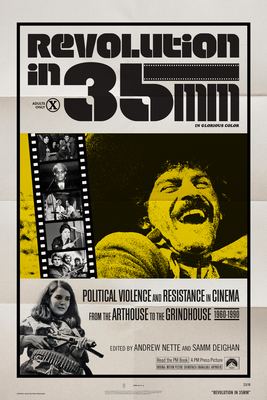Revolution in 35mm: Political Violence and Resistance in Cinema from the Arthouse to the Grindhouse, 1960-1990

Revolution in 35mm: Political Violence and Resistance in Cinema from the Arthouse to the Grindhouse, 1960-1990
Revolution in 35mm: Political Violence and Resistance in Cinema from the Arthouse to the Grindhouse, 1960-1990 examines how political violence and resistance was represented in arthouse and cult films from 1960 to 1990.
This historical period spans the Algerian war of independence and the early wave of post-colonial struggles that reshaped the Global South, through the collapse of Soviet Communism in the late '80s. It focuses on films related to the rise of protest movements by students, workers, and leftist groups, as well as broader countercultural movements, Black Power, the rise of feminism, and so on. The book also includes films that explore the splinter groups that engaged in violent, urban guerrilla struggles throughout the 1970s and 1980s, as the promise of widespread radical social transformation failed to materialize: the Weathermen, the Black Liberation Army and the Symbionese Liberation Army in the United States, the Red Army Faction in West Germany and Japan, and Italy's Red Brigades.
Many of these movements were deeply connected with and expressed their values through art, literature, popular culture, and, of course, cinema. Twelve authors, including academics and well know film critics, deliver a diverse examination of how filmmakers around the world reacted to the political violence and resistance movements of the period and how this was expressed on screen. This includes looking at the financing, distribution, and screening of these films, audience and critical reaction, the attempted censorship or suppression of much of this work, and how directors and producers eluded these restrictions.
Including over two hundred illustrations, the book examines filmmaking movements like the French, Japanese, German, and Yugoslavian New Waves; subgenres like spaghetti westerns, Italian poliziotteschi, Blaxploitation, and mondo movies; and films that reflect the values of specific movements like feminists, Vietnam War protesters, and Black militants. The work of influential and well-known political filmmakers such as Costa-Gavras, Gillo Pontecorvo, and Glauber Rocha is examined side by side with grindhouse cinema and lessor known titles by a host of all-but forgotten filmmakers, including many from the Global South, that are deserving of rediscovery.
PRP: 208.73 Lei
Acesta este Prețul Recomandat de Producător. Prețul de vânzare al produsului este afișat mai jos.
187.86Lei
187.86Lei
208.73 LeiLivrare in 2-4 saptamani
Descrierea produsului
Revolution in 35mm: Political Violence and Resistance in Cinema from the Arthouse to the Grindhouse, 1960-1990 examines how political violence and resistance was represented in arthouse and cult films from 1960 to 1990.
This historical period spans the Algerian war of independence and the early wave of post-colonial struggles that reshaped the Global South, through the collapse of Soviet Communism in the late '80s. It focuses on films related to the rise of protest movements by students, workers, and leftist groups, as well as broader countercultural movements, Black Power, the rise of feminism, and so on. The book also includes films that explore the splinter groups that engaged in violent, urban guerrilla struggles throughout the 1970s and 1980s, as the promise of widespread radical social transformation failed to materialize: the Weathermen, the Black Liberation Army and the Symbionese Liberation Army in the United States, the Red Army Faction in West Germany and Japan, and Italy's Red Brigades.
Many of these movements were deeply connected with and expressed their values through art, literature, popular culture, and, of course, cinema. Twelve authors, including academics and well know film critics, deliver a diverse examination of how filmmakers around the world reacted to the political violence and resistance movements of the period and how this was expressed on screen. This includes looking at the financing, distribution, and screening of these films, audience and critical reaction, the attempted censorship or suppression of much of this work, and how directors and producers eluded these restrictions.
Including over two hundred illustrations, the book examines filmmaking movements like the French, Japanese, German, and Yugoslavian New Waves; subgenres like spaghetti westerns, Italian poliziotteschi, Blaxploitation, and mondo movies; and films that reflect the values of specific movements like feminists, Vietnam War protesters, and Black militants. The work of influential and well-known political filmmakers such as Costa-Gavras, Gillo Pontecorvo, and Glauber Rocha is examined side by side with grindhouse cinema and lessor known titles by a host of all-but forgotten filmmakers, including many from the Global South, that are deserving of rediscovery.
Detaliile produsului










